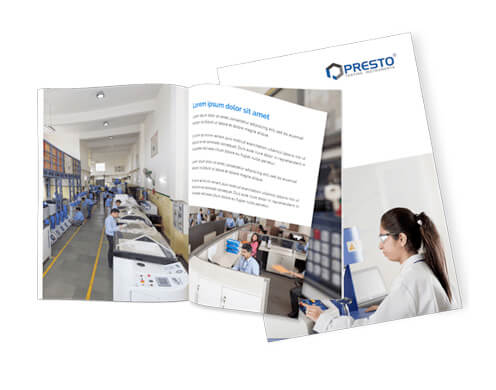How Tensile Testing Specimen Prepared and Mounted for a Tensile Test?
.png)
Tensile strength testing is a fundamental procedure in quality assurance to evaluate the maximum load a material can withstand without breaking or deforming. Manufacturers across various industries conduct quality assurance tests to verify the strength of materials when subjected to tensile forces. By quantifying a material's stress tolerance, manufacturers can make informed decisions and guarantee the delivery of high-quality materials to their customers. Therefore, with the assistance of the Presto tensile strength tester, manufacturers can conveniently perform tensile strength tests on their materials, thereby ensuring the accurate delivery of products to their customers.
Presto is one of Asia’s top manufacturers of tensile testing machines and designs this quality testing equipment with highly advanced features. The digital model of the Presto tensile strength tester will help the manufacturers ensure accuracy in product quality.
In this blog, we will discuss brief information about the Presto tensile strength tester and how you can easily mount the specimen in this testing equipment for accurate testing.
Introduction to Tensile test and its Importance in Different Industries
As previously mentioned, the tensile strength test stands as a widely used quality assurance method, aiding manufacturers in confirming the durability of materials under the influence of tensile forces. Tensile strength testing serves a pivotal role across various industries such as automotive, aerospace, construction, and more. By precisely gauging the tensile strength of materials, manufacturers can readily make informed judgments about a product's appropriateness for its intended applications. Achieving this accuracy in test results is facilitated through the utilisation of standardised laboratory testing equipment, ensuring manufacturers maintain precise quality assessments. Presto digital tensile strength testing machine has been designed as per industrial standards and works on a constant rate of traverse principle. It has been equipped with an upper and lower jaw that makes it easy for the manufacturers to conduct quality tests on the materials.
Now, let us discuss brief information about the Presto tensile strength tester.
All about Presto digital tensile strength tester
The Presto Tensile Testing Machine comes highly recommended for assessing the tensile strength of various products and materials. This equipment operates based on the Constant Rate of Traverse (CRT) principle and features both an upper and lower jaw.
The upper jaw remains stationary, while the lower jaw can be smoothly moved at a predetermined fixed speed with the assistance of a motor. Test specimens are securely held between these two jaws, and the lower jaw is progressively adjusted to determine the tensile strength of the sample. The motor is equipped with a gearbox and lead screw arrangement, ensuring precise control. Additionally, the machine incorporates a specialised sensor linked to a load cell, which accurately measures the load applied to the stationary jaw and displays the reading in kilograms in a digital format.
To enhance stability and durability, the Presto Tensile Testing Machine utilises case-hardened lead screws. It is also fitted with a reputable motor and adheres to CE standard electrical wiring. The machine's modular design makes it easy to maintain and operate, ensuring a trouble-free experience. This digital tensile strength testing machine makes it easy for the manufacturers to conduct tensile strength tests on the materials. You can easily perform tensile strength test on the materials with the help of this quality testing equipment.
Now, let us discuss a brief about the features and technical specifications of this quality testing equipment.
Features of Presto digital tensile tester
Advanced load sensor sensing through advanced electronics.
Highly sensitive load sensor with linearity feature and repeatability
Cross-head travel length: 750mm grip to grip
Single-column rugged structure
Safety limit switches for over-travel safety
Hardened lead screws for frictionless movement
Load cell calibrated by NPL-approved proving ring/dynamometers
High accurate microcontroller system controls
Peak Hold facility available
Bright LED display
Immediate analysis of results after the test with complete accuracy & precision
Feather touch controls
With these high-quality features and technical specifications, manufacturers can easily conduct tensile strength tests on the materials and determine their durability against tensile force.
Now, let us discuss briefly how you can easily prepare and place the testing specimen on this quality testing instrument.
How to prepare and place the testing specimen on the Presto digital tensile tester?
To accurately prepare and mount the testing specimen on a Presto digital tensile strength tester, manufacturers can easily follow the steps mentioned below:
Preparation of Rectangular Shape Specimen
Cut a Strip of 25 mm width or the desired width having the appropriate length.
Now mark the specimen strip as follows for measuring gauge length.
Marking should be done in such a way that the distance between the grips of the machine is exactly required as gauge length after clamping of the specimen.
This distance can vary from test standard to test standard.
Clamp the specimen from both ends to ensure proper and equal clamping force on the specimen on both ends.
Placement of Specimen
Place the lower side of the specimen between the lower fixed grips and tighten the grip firmly. (for pneumatic clamping, go to the menu, press Clamping ON/OFF, and select ON for lower gripping)
Now bring the upper movable grip upwards so that the specimen can easily reach the grips. & Place the lower end of the specimen between the lower grips and tighten the grip firmly.(go to the menu, press Clamping ON/OFF, and select ON for upper gripping)
Ensure that the lower limit switch ring is placed at a position that keeps a minimum distance of 25 mm.
Make sure that the specimen is placed in the centre of the grips.
In this way, you can easily prepare and place the testing specimen on the tensile testing machine. If you want to know more about this testing instrument like it’s working procedure or tensile tester price or want to buy tensile test machine, then you can give us a call at +91 9210903903 or email us at info@prestogroup.com. Our team of technical experts will consult you regarding all your queries.
Author : -Gaurav Malhotra
you may also like
- Avoiding Road Transit Hassles with the Vibration Table
- Attain Firm & Integrated Bottle Closures with the Digital Torque Tester
- Avoid Product Damage due to Slippage with the Coefficient Of Friction Tester
- Guarantee Robust Corrugated Sheets with the Edge Crush Tester
- How to Make Deformation Resistant Cartons with the Box Compression Tester?
Recent News
- Paper & Packaging Testing Instruments
- Paint, Plating & Coating Testing Instruments
- Plastic & Polymer Testing Instruments
- Environmental Testing Chambers
- PET & Preform Testing Instruments
- Color Measuring Testing Instruments
- View Entire Range Instruments

Catalogue 2023
Get information about new product launches, research, innovation and endeavors at Presto.
download Free Copy
Quick quote

